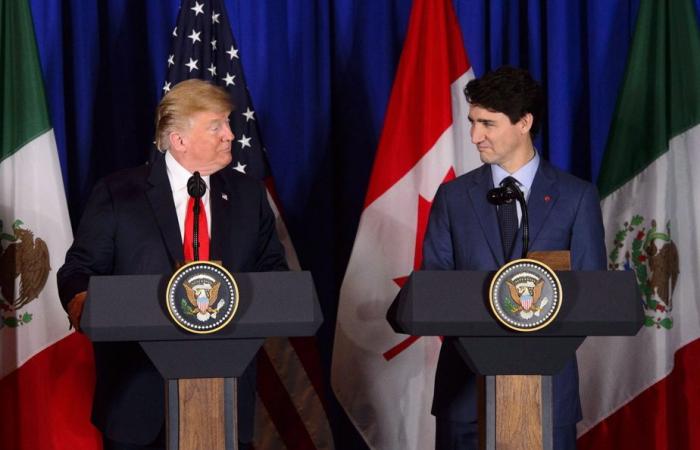Donald Trump will only be president in two months, but he is already playing his cards. He wants to impose customs duties of 25% on all products imported from Canada and Mexico, even if it means renegotiating the 2018 Canada–United States–Mexico Agreement.
Published yesterday at 7:30 p.m.
An agreement negotiated and signed by Mr. Trump in his first term and which replaced the previous free trade agreement between the three countries, which the American president had described as “the worst trade agreement of all time”.
Anyway, here we go again. Negotiations will have to be resumed with the chief bully. Except that it may be much more complicated with the 47e president of the United States than it was with the 45e.
In a message on his Truth Social network, Mr. Trump said Monday evening that he would impose tariffs of 25% on exports from Canada and Mexico and an additional 10% on Chinese products.
PHOTO SEAN KILPATRICK, CANADIAN PRESS ARCHIVES
Donald Trump and Justin Trudeau at the signing ceremony of the Canada–United States–Mexico Agreement, in 2018
We must, of course, take Mr. Trump’s threats seriously. But still not too much. Because we can’t yet know if these are just intimidation tactics and a show of force to get something else. Does Mr. Trump really believe it is in his interest to impose these tariffs?
Mr. Trump said several times during the election campaign that the word “tariff” was the most beautiful word in the dictionary. We cannot therefore be surprised that he is thinking of imposing them.
But the fact remains that there are plenty of contradictions in Mr. Trump’s project. Contradictions that could cost him dearly, politically.
Mr. Trump was elected in large part – the polls clearly show this – because of a prolonged inflationary surge. Many voters wanted to punish the Biden-Harris administration for failing to act when it was time.
But, whatever President Trump says, a good way to revive inflation is precisely to impose customs tariffs on products used in the manufacture of everyday consumer goods. If aluminum from Quebec costs 25% more for a car manufacturer in the United States, it will inevitably pass the bill on to consumers.
When totaled, products from Canada, Mexico and China make up about 42% of U.S. imports. This is starting to create a lot of products that will cost more for Americans. We’re talking about imports totaling $1.5 trillion (or $1.5 million million).
In Canada, major economic players do not seem convinced that Mr. Trump is serious and they do not believe at all that customs duties could help the American economy without restarting inflation.
We cannot be more competitive with China if we make Alberta oil or Quebec aluminum unaffordable.
Flávio Volpe, president of the Canadian Automotive Parts Manufacturers Association
Additionally, supply chains are so integrated in this area that a car can cross the border multiple times during its construction.
Since we are talking about oil, we must remember that Canada is a reliable partner for the United States, which buys no less than 60% of Canadian crude oil. And a 25% customs tariff will inevitably increase the price of gasoline at the pump, one of the factors that has contributed the most to inflation in recent years.
While waiting for January 20, we must start preparing for negotiations immediately. Above all, we must not think that the strategies that worked in 2017 will still be the best suited.
It is certain that the provinces must have a voice and that we must demonstrate to the Americans the close links between our economies and our supply chains.
But Mr. Trump wants to talk about immigration and drug trafficking and he is only using an economic weapon to try to solve problems that are not economic.
In context, the strategy of “Team Canada” undoubtedly needs to be rethought.
Likewise, some provincial premiers wanted, more or less directly, that Canada approach these negotiations without allying with Mexico, since President Trump mainly complains about irregular immigration and drug trafficking, more Mexican problems. than Canadians.
But the demands of a possible negotiation with the Trump administration should bring us closer to Mexico rather than further from it. We now know President Trump’s negotiation technique: divide and conquer.
Even if our interests do not always completely converge with those of Mexico, the fact remains that the negotiation will be more difficult if Canada is alone facing the United States than if a third actor is at the same table.
What do you think? Participate in the dialogue







